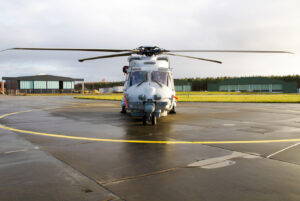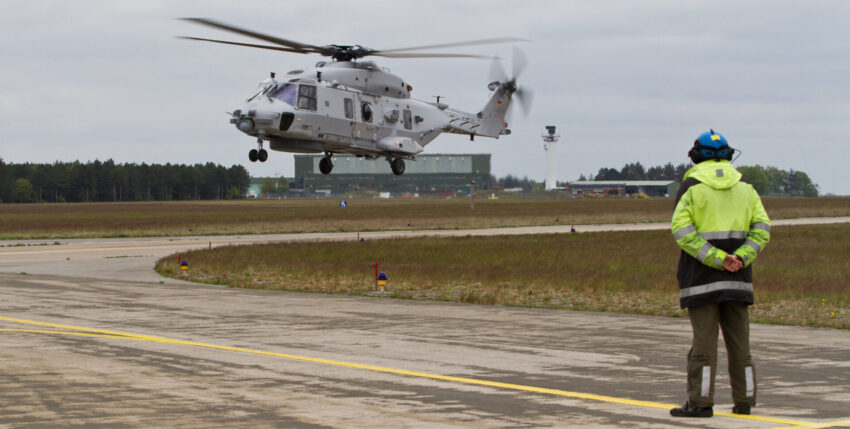A far-reaching system change is currently taking place in the German Navy's helicopter sector. Over the next few years, the tried-and-tested Sea King Mk 41 and Sea Lynx Mk 88A helicopters will be replaced by the NH90 NGEN (company name of the German naval variant) in the NTH (Naval Transport Helicopter, Sea Lion) and MRFH (Multi-Role Frigate Helicopter, Sea Tiger) variants.
At the same time, this requires a change in previous ways of thinking and working as well as in "established" operational procedures, as the NH90 NGEN offers extensive new, modern capabilities. In order to make optimum use of these, the crews and supervisors on land and on board have to rethink - away from the old, analogue helicopter with a focus on aeronautical handling, towards the new, digital helicopter with a focus on the optimum use of the overall system.
The use of helicopters to date
The Sea King and Sea Lynx helicopters are used for all operational missions with a fixed crew size and distribution of tasks. The crew of the Sea King consists of two pilots, an aircraft operations officer and an on-board mechanic. The on-board mechanic has master-level technical training and medical training as a paramedic.
The crew of the Sea Lynx consists of two pilots and a helicopter locator. The left-hand pilot has advanced tactical training as he operates the radar and navigation system and leads the tactical mission. The helicopter location master has specialised training in underwater location at master level.
Both helicopters have support systems for the pilots, such as automatic altitude hold or automatic hovering over water. However, due to the age of the helicopters, the range of functions no longer corresponds to today's possibilities. Especially at night or in bad weather, support from the second pilot is required. In both helicopters, operation of the radar, the electro-optical sensor and the navigation system is limited to one workstation. This means that in a tactical or SAR (search and rescue) scenario, the main workload lies with one person.
Conversion NH90 NGEN
The NH90 NGEN is introduced into the navy in various states of readiness. The first NTH transport helicopters are delivered in Step 1, which has certain functional limitations. The following helicopters will be delivered in Step 2 configuration, which fully fulfils the requirements of the navy. The remaining Step 1 machines will then be upgraded to Step 2. This configuration reflects all the capabilities of the French NH90 NFH (NATO Frigate Helicopter).
The MRFH combat helicopter is based on this French configuration, which represents the Step 3 configuration with additional functions, sensors and effectors. The full range of functions for the MRFH will be achieved with Step 4.
Compared to Sea King and Sea Lynx, NTH and MRFH offer a variety of new sensors and much-needed effectors. These are all configured, controlled and operated via the mission system. This gives the management of electronics and information a much higher priority than before.
Sensors
With the European Naval Radar (ENR) maritime surveillance radar, the NH90 NGEN offers new possibilities that go far beyond previous systems. The 360-degree radar has a range of over 150 miles and can schematically map and classify surface contacts in the Inverse Synthetic Aparture Radar (ISAR) operating mode. Another new feature is the ability to interrogate the radar transponders of aircraft (Identification Friend Foe) and display the information in the mission system.
In addition, there is a more powerful electro-optical and infrared sensor (EO/IR), which can be used to measure distances and thus determine the exact position of a contact. NTH and MRFH also have a system for electronic warfare (EloKa), which can be used to detect, analyse, assign and record signals. This also includes recognising threats and triggering countermeasures, such as launching radar or infrared decoys to counter an attack by guided missiles.
The Automatic Identification System (AIS) is available as an additional sensor. The system, which was developed for maritime navigation, enables the display of ship contacts with extensive additional information. Aircraft with special roles, such as SAR helicopters, can also be displayed in this comprehensive system.
The MRFH must be deployed as an on-board helicopter in a joint operation, primarily in the area of underwater naval warfare. Like the Sea Lynx, it has a diving sonar that is used in hover flight and can search for underwater contacts at various depths. In contrast to the Sea Lynx, the MRFH's dipping sonar operates in the low-frequency range, which leads to significantly greater detection ranges. In addition, the MRFH can also drop, monitor and analyse sonar buoys. The combination of low-frequency dipping sonar and sonar buoys will enable the use of modern bi- and multi-static localisation methods with long ranges in the future.
Effectors
Up to two M3M heavy machine guns can be installed in both the NTH and the MRFH. Previously, it was only possible to fit one M3M, meaning that the operational options in this area have also been expanded.
Like the Sea Lynx, the MRFH also has the ability to engage enemy underwater targets with modern MU90 torpedoes. In addition, the MRFH can be armed with sea-target guided missiles, as was the case with the Sea Lynx until 2014. However, these are not part of the NH90 project, but have to be procured in a lengthy, separate process. The new missile has a significantly longer range and can also be used against land targets. This requires the adaptation or new development of corresponding deployment procedures.
Electronics
In addition to the larger number of sensors and effectors, the NTH and MRFH have new radio and data links, including satellite communication and tactical data link. These devices are operated and controlled centrally via the mission system. With the switch to NH90 NGEN, the "knob-and-button" system is changing from the previous, predominantly analogue systems to a much more modern, comprehensive and digital "menu and system" system. In order to be able to use the NH90 weapon system effectively and efficiently, it is essential to be able to find your way around the 2,000 or so menu pages quickly and with procedural and operational certainty - even in the NTH variant and even more challenging in the new MRFH variant.
The extensive electronics on board the helicopter can no longer be quickly fed with data by hand before the flight. Databases, frequency tables and digital maps are just some of the information that the system needs to operate effectively. This data must be prepared with the help of ground stations and then loaded into the helicopter using data carriers - not only for operational purposes, but also for technical operations. After the flight, data must be transferred from the helicopter to the corresponding ground stations: recorded information from the electro-optical sensors, the radar, the EloKa system, the sonar system and the technical consumption and operating data. In addition to the Nordholz naval air base, these ground stations must also be available at the SAR outposts, on the task force supply ships and on the frigates with embarked helicopters. For on-board use, the ground station is supplemented by a mobile system for the maintenance, logistics and operational management of the NH90 NGEN.
Information management
The higher number of sensors, effectors and communication links inevitably increases the amount of information data. The efficient internal and external management of this information is the most important prerequisite for the effective use of this modern helicopter.
Internal information management is about who operates which sensor and who uses and interprets which data provided by the mission system. This is made possible by the various multifunctional displays in the helicopter, which can display different data and functions depending on the mission scenario. External information management is about who transmits which data to external bodies, such as a ship or a control centre on land, or requests it from them. From Step 2 onwards, the NH90 offers significantly enhanced capacities for the creation and, in particular, the transmission of the situation picture, for example through the installation of an improved tactical data link. In view of the rapid and necessary development in the digitalisation of command and control capabilities, this is an important and decisive prerequisite for future deployment options. However, data exchange via link currently increases the workload enormously. On board ships or maritime surveillance aircraft, there is an operator who does nothing else but operate the link system.
Concentrating all of these tasks at one workstation, as was the case with the Sea King and Sea Lynx, is no longer feasible from an operational perspective. In the NH90, the mission system can be operated from any workstation in the helicopter, so that the various tasks can be carried out by several crew members at the same time. Depending on how demanding the mission is, one to three other operators are required in addition to the pilot in order to utilise the helicopter effectively. At the lower end of the performance spectrum is a transport flight on land, during the day and without a threat, where a crew of three is sufficient to simply fly a navigation route. At the upper end of the spectrum is a tactical sonar mission on board a frigate at night in a tactical scenario with a threat. Here, four people are required to create and maintain an air, surface and underwater situation picture and to react quickly to changes in the situation. Accordingly, the crew composition must be flexible enough to cover the different mission requirements. In addition, in some complex scenarios it is essential that the left-hand pilot can operate the mission system and sensors in a targeted manner. In the future, the mission options will therefore no longer be determined solely by the helicopter's set-up role, but above all by the technical and systemic qualifications of the crew.
Consequences for the design areas
The consequences for the individual design areas are only outlined in brief. It is essential to deal with the complexity of the weapon system and to make greater use of the similarities between NTH and MRFH.
- Personnel: The great similarity between NTH and MRFH makes it possible to use both variants.
- Training, deployment, exercises: The new operational capabilities of the helicopters must be determined as part of the operational test in the most demanding scenarios of underwater and surface warfare and then expanded and consolidated in further exercises.
- Material, equipment: New capabilities require the procurement of additional material such as sonar buoys or sea-target guided missiles. The aim must be to procure the necessary armament for a combat helicopter in good time so that the engagement of underwater and surface targets can already be tested during operational testing.
- Multinationality: The new possibilities for multinational cooperation at operational level, especially with other NH90 users, must be continuously tested during joint exercises. At the planning level, the procurement and integration of new effectors such as modern missiles or torpedoes appears to be more feasible in a multinational organisation. Procurement processes need to be accelerated through the mutual recognition of authorisation documents to ensure timely delivery and rapid deployment.
- Infrastructure: The NH90 is significantly larger and heavier than the Sea Lynx. As a result, the space required for parking, maintenance and repair for the NH90 fleet is also greater than the space previously required for the Sea King and Sea Lynx combined. Due to the powerful sea-target guided missiles, correspondingly large safety distances must be observed when storing, loading and unloading the weapons on land. The infrastructure processes are currently taking so long that construction work, for example for the MRFH simulator, would have to be commissioned before the contract for the helicopter is signed. As this is not possible, alternative options may have to be considered.
- Methods, procedures: The new capabilities of the NH90 in terms of flight support for the pilot and the improved sensor, effector and mission equipment allow the development of the necessary new flight and tactical procedures. Depending on the mission, the support of specially trained personnel and the availability of a sono ground station and an EloKa ground station are essential for the tactical preparation and follow-up of flights. The operational assessment of requirements for the procurement of decoys (chaff and flare) and corresponding effectiveness tests must be accompanied by specialist munitions expertise.
- Conception, concepts: The ability to operate the mission system via multifunctional displays at all workstations must be taken into account in the composition and qualification of the crew.
- Organisation, operation: The numerous IT systems make it possible to map the various mission scenarios from public to classified in different constellations. This requires intensive IT support before, during and after missions to optimise the effective deployment of helicopters. The processes for flight operations and deployment on board task force supply aircraft and frigates must be adapted to the more extensive capabilities of the helicopters.

Outlook for the future
The successor to the Sea Lynx is to be an overall system consisting of a manned and an unmanned component that can be deployed together in Manned-Unmanned Teaming (MUM-T). With the selection decision in favour of the NH90 MRFH combat helicopter, the manned component has been determined, subject to parliamentary approval. The integration of MUM-T is to take place in the Step 4 armament phase. The exact requirements for the unmanned component still need to be further specified.
Nevertheless, it is already a good idea to follow the current state of the art and to incorporate and implement possible demands from the navy in research projects. Initial ideas include the automated reconnaissance of contacts in a sea area as part of surface naval warfare and the search for people in a sea rescue case. In both scenarios, it is helpful if the data from several sensors such as radar, AIS and EO/IR are superimposed or merged when searching in an operational area. This helps to increase the probability of detection in SAR cases and allows an initial classification when searching for contacts.
In the longer term, it is conceivable that unmanned systems could also be used for underwater naval warfare. In this scenario, they could deploy sonar buoys and relay their signals for analysis, serve as a relay station for radio communication between ships and helicopters over long distances or be used in teaming with a maritime reconnaissance aircraft. This requires, among other things, the further development of authorisation procedures, as the dropping of sonar buoys from an unmanned system will require the acceptance of a certain level of risk in the future.
To look even further into the future, three topics are presented here that are still at a multinational stage of development but offer great potential for future applications.
The company Raytheon has developed an Unmanned Underwater Vehicle (UUV) that can be used to identify and destroy mines. In the final version, the UUV will only be the size of a sonar buoy. This means that an NH90 could deploy up to 20 of these UUVs from the air in future.
The company Ultra Electronics has developed an unmanned aerial vehicle (UAV) that is only half the size of a standard sonar buoy. The UAV can be launched from a buoy launcher and has a flight time of around one hour. One NH90 NGEN could therefore launch a total of 20 UAVs or two swarms of ten UAVs each to achieve the mission objectives.
The company DSG has developed supercavitating ammunition in 12.7 millimetre calibre that can be used to shoot into the water from a helicopter. The design of the projectile almost completely eliminates ricochets and allows a large penetration depth into the water. According to DSG, a 12.7 millimetre calibre projectile can penetrate a 20 millimetre thick steel plate after 20 metres of transit through the water. This means that the NH90 with the M3M heavy machine gun could also be used against targets in shallow water, such as mines, UUVs, submarines or torpedoes.
Conclusion
The NH90 NGEN brings with it many new capabilities and considerable potential for the future. The similarity between the NTH and MRFH versions results in operational and technical-logistical synergies. In order to utilise the new capabilities effectively, a rethink is absolutely essential. In particular, the increased requirements in the areas of information management, IT equipment and connectivity, support from external specialised personnel and the engagement of targets at long distances have a serious impact. These influence the composition and qualification of crews, the processes for preparing and following up flights and the complex deployment procedures. The unchanged transfer of existing procedures and processes to the NH90 does not make sense, as the new capabilities cannot be utilised efficiently or at all.
The acceptance of the NH90 helicopter (90 stands for the 1990s!) 30 years after its initial conception shows that many processes are too bureaucratic and take too long. The introduction of the NH90 NGEN offers the opportunity to review all processes and structures in order to streamline them. A rethink is also necessary here - at all levels.
Text: Markus Kafurke, Photos: Bundeswehr/MFG 3










